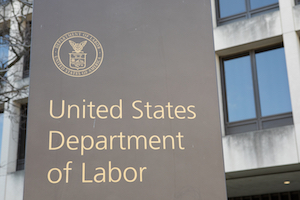 In comments to the Department of Labor (DOL), the American Retirement Association (ARA) argues that proposed changes to the QPAM Exemption would “needlessly” disrupt plan relationships and increase costs for plan sponsors and participants — with no obvious corresponding benefit.
In comments to the Department of Labor (DOL), the American Retirement Association (ARA) argues that proposed changes to the QPAM Exemption would “needlessly” disrupt plan relationships and increase costs for plan sponsors and participants — with no obvious corresponding benefit.
The ARA’s letter comes in response to the DOL’s proposed amendment released July 26 to Prohibited Transaction Class Exemption 84–14 — also known as the Qualified Professional Asset Manager (QPAM) Exemption. In general, the QPAM exemption permits various parties who are related to plans to engage in transactions involving plan and individual retirement account assets if the assets are managed by QPAMs that are independent of the parties in interest and that meet specified financial standards.
The DOL had described the proposed changes as “modernizing” the exemption since it was first issued nearly 40 years ago. The changes would, among other things, expand the types of misconduct that disqualify plan asset managers from using the exemption and would clarify that foreign convictions disqualify firms from utilizing the QPAM.
“While the Department explains the objective for the Proposal is to protect plans, participants, and beneficiaries, despite over forty years of exemption compliance enforcement, the Department provides little objective support to demonstrate the need for the sweeping changes it proposes,” the ARA states in the letter. “To the contrary, the Department readily admits in many instances, it lacks data for elements of its economic analysis.”
The ARA adds that it supports conditions for exemptive relief which provide necessary protections to plans and imparts clarity to the fiduciary investment selection and management process without disrupting and interfering with relationships that otherwise function well.
The organization’s concerns fall into two primary categories: the proposal’s impacts on (1) plan sponsors and (2) plan investment options. The ARA’s key recommendations to the DOL include:
- modifying the exclusive authority condition of the proposed amendment to Section I(c) of the QPAM Exemption so as to not preclude routine business interactions;
- modifying the conditions of the one-year winding down period of proposed new Section I(j) so as not to preclude new transactions in existing accounts which are required for a prudent winding down process; and
- providing at least 18 months for QPAMs, plan sponsors and other parties-in-interest to come into compliance with the conditions of an amended QPAM Exemption.
Exclusive Authority Requirement
Though the DOL characterizes this requirement as a “clarification” that aligns with the 1982 proposal for the QPAM Exemption, the ARA believes it adds “unjustified and redundant restrictions” to a material and meaningful condition of the exemption.
As part of its proposal, the DOL is seeking to make clear that a QPAM must not permit other parties in interest to make decisions regarding plan investments under the QPAM’s control. “We understand that the impetus for this stems from a concern that plans sometimes engage ‘QPAMs for a Day’ to uncritically ratify prearranged transactions,” the ARA explains, adding that, “The Proposal’s exclusive authority requirement, however, would have an outsize effect relative to its potential efficacy relating to the extent of QPAMs’ involvement in transactions.” As such, the ARA recommends that established business practices, which preserve the QPAM’s “ultimate discretion,” should be permitted even if a party-in-interest has a degree of involvement in the transaction.
Mandatory One-Year Winding Down Period
The ARA further argues that this limitation puts plans at risk — including risks of violating otherwise applicable fiduciary duties because the QPAM cannot enter new transactions, i.e. those that might otherwise be required for prudent unwinding of existing transactions. The ARA believes the proposal should be modified to permit the QPAM to engage in transactions which are required for a prudent winding down process.
The organization also notes that it is concerned about the feasibility of a solution which involves obtaining individual QPAM exemptions, given the relatively few individual exemptions granted in recent years and the significant new requirements of the proposal. To minimize disruption to plans’ relationships with QPAMs, the ARA urges the DOL to modify the proposal to provide that the one-year winding down period would not begin until the department renders a final determination on the QPAM’s request for an individual exemption.
Indemnification/Written Management Agreement
The ARA is concerned that this change is unsupported and unwarranted interference into the process of contracting with plan service providers that would have enormous consequences for plansThe proposal includes a call for a requirement that QPAMs’ written management agreements with plans to include terms addressing the potential future ineligibility of the QPAM for prohibited transaction relief.
“Every investment management agreement that is currently in place between an ERISA plan and a QPAM will need to be amended. We believe that it would be prohibitively difficult for plans to complete the required amendments in such a brief time frame, exacerbating problems resulting from the substance of the Proposal,” the ARA’s letter contends, adding that some plan sponsors have management agreements with multiple QPAMs.
For these reasons, the ARA believes that the extensive changes needed to bring QPAM agreements into compliance with the proposal require at least 18 months.
Plan Investments
Regarding plan investments, the ARA emphasizes that, in today’s financial markets, the QPAM exemption is widely relied upon as a source of prohibited transaction relief in connection with investment vehicles that are popular under employer-sponsored retirement plans. Consequently, the ARA is concerned about the impact of proposal on these investments and the resulting impact on employer-sponsored retirement plans. Of particular concern are target date funds, frequently selected as qualified default investment alternatives (QDIAs), and collective investment trusts (CITs).
- Log in to post comments
